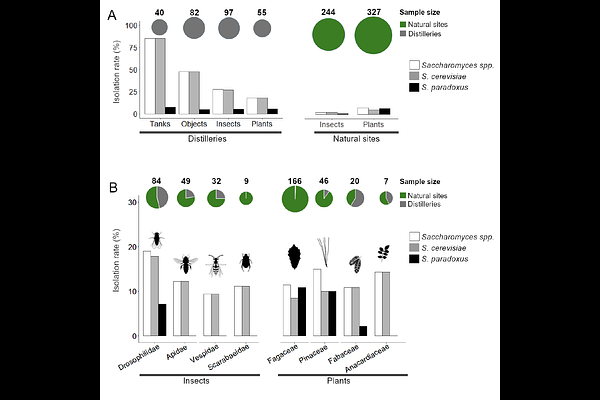Ecological divergence of sympatric Saccharomyces species across wild and fermentative environments in the neotropics

Ecological divergence of sympatric Saccharomyces species across wild and fermentative environments in the neotropics
Lopez-Gallegos, C.; Aguirre-Dugua, X.; Avelar-Rivas, J. A.; Kirchmayr, M. R.; Morales, L.; DeLuna, A.; Mancera, E.
AbstractThe common yeast Saccharomyces cerevisiae is widely associated with anthropogenic habitats and dominates agave fermentations in Mexico, despite the absence of starter cultures in artisanal production. Yet, the origins and dispersal of the microorganisms involved in this fermentation system--including wild S. cerevisiae and its sister species S. paradoxus--remain poorly understood. Here, we analyzed the distribution of these two species across three regions in Mexico by collecting a total of 861 samples from 15 traditional distilleries and 25 nearby natural sites, including tree bark, insects, fermentation tanks, and distillery surfaces. Among 4,006 isolates identified by MALDI-TOF biotyping, S. cerevisiae and S. paradoxus were recovered at overall rates of 21% and 3.4%, respectively, with the former more frequently found in distilleries and the latter in natural habitats. Notably, Saccharomyces isolates were not exclusively associated with oak trees, as strains were also recovered from leguminous, pine, and Anacardiaceae trees, suggesting that the oak specialization observed in temperate regions may not hold in tropical environments. Genome sequencing of 100 Saccharomyces isolates and SNP-based analyses showed that S. cerevisiae strains clustered by geography, not by substrate, and were largely confined to two Mexican Agave clades, with minor representation from the North American Oak, Pacific West Coast, and Wine clades. Strains isolated from agave fermentations belonged to the same populations as those from plant substrates, with insects, especially Drosophilidae, likely mediating their dispersal. Meanwhile, S. paradoxus isolates grouped into the SpA (Eurasian) and SpB (North American) lineages, with three novel SpB subclades identified. Intriguingly, one of these, the SpB_MxAgave population, was exclusively associated with agave fermentations, providing the first evidence of a persistent association of S. paradoxus with an anthropogenic habitat. Our study sheds light on the ecological dynamics and diversity of S. cerevisiae and S. paradoxus populations in the neotropics.